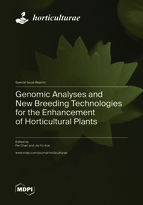Genomic Analyses and New Breeding Technologies for the Enhancement of Horticultural Plants
A special issue of Horticulturae (ISSN 2311-7524). This special issue belongs to the section "Genetics, Genomics, Breeding, and Biotechnology (G2B2)".
Deadline for manuscript submissions: closed (20 May 2023) | Viewed by 26591
Special Issue Editors
Interests: molecular horticulture; genomics and data visualization; germplasm and landscape
Interests: the transition of plants from aquatic to terrestrial environment; the origin and early diversification of angiosperms; plant-pathogen interactions
Special Issues, Collections and Topics in MDPI journals
Special Issue Information
Dear Colleagues,
Since the first release of a horticultural crop (grapevine) genome in 2007, there have been hundreds of genome sequences of horticultural plants available to the public. These genome sequences have unprecedentedly facilitated the decoding of genes responsible for the horticultural traits of horticultural crops, including the fruit crops, vegetable crops, ornamental crops, beverage crops, and medicinal crops. In order to promote the findings in this area, here, on behalf of the journal Horticulturae, we sincerely invite you to submit your work to our Special Issue “Genomic Analyses and New Breeding Technologies for the Enhancement of Horticultural Plants”. The focus of this issue will be genomic analyses of genes responsible for horticultural traits, as well as breeding technologies for horticultural crops. Reviews and original articles will be welcome.
Prof. Dr. Fei Chen
Prof. Dr. Jia-Yu Xue
Guest Editors
Manuscript Submission Information
Manuscripts should be submitted online at www.mdpi.com by registering and logging in to this website. Once you are registered, click here to go to the submission form. Manuscripts can be submitted until the deadline. All submissions that pass pre-check are peer-reviewed. Accepted papers will be published continuously in the journal (as soon as accepted) and will be listed together on the special issue website. Research articles, review articles as well as short communications are invited. For planned papers, a title and short abstract (about 100 words) can be sent to the Editorial Office for announcement on this website.
Submitted manuscripts should not have been published previously, nor be under consideration for publication elsewhere (except conference proceedings papers). All manuscripts are thoroughly refereed through a single-blind peer-review process. A guide for authors and other relevant information for submission of manuscripts is available on the Instructions for Authors page. Horticulturae is an international peer-reviewed open access monthly journal published by MDPI.
Please visit the Instructions for Authors page before submitting a manuscript. The Article Processing Charge (APC) for publication in this open access journal is 2200 CHF (Swiss Francs). Submitted papers should be well formatted and use good English. Authors may use MDPI's English editing service prior to publication or during author revisions.
Keywords
- horticultural crops
- genomic analyses
- genome sequence
- molecular breeding







